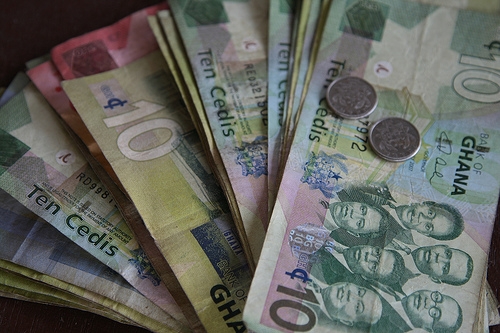
Aside the pass-through effects of increases in taxes, petroleum levies and utility costs coupled with energy supply challenges, the weak monetary transmission mechanism has typically been cited as a key contributing factor to the high rate of inflation.
Background
Headline inflation as measured by the CPI for July 2016, declined sharply to 16.7 percent from the 18.4 percent in June 2016 according to the Ghana Statistical Service. Yet the high rate of inflation remains a major macroeconomic challenge in Ghana. Hence it is vital to appreciate the relevant dynamics with the view to further reduce inflationary pressure.
Aside the pass-through effects of increases in taxes, petroleum levies and utility costs coupled with energy supply challenges, the weak monetary transmission mechanism has typically been cited as a key contributing factor to the high rate of inflation. Table 1 demonstrates the increasing trajectory of inflation rate since 2011.
Table 1: Inflation rate (%)
| Year-on-year Inflation (%) | 2011 | 2012 | 2013 | 2014 | 2015 |
| End period | 8.6 | 8.8 | 13.5 | 17.0 | 17.7 |
| Annual average | 8.7 | 9.2 | 11.4 | 15.4 | 17.1 |
Source: Ghana Statistical Service
Also, the chart below summarizes key insights in explaining why the transmission mechanism has been weak, that is, increases in monetary policy rate (MPR) have not significantly led to increases in lending rates.

To commence the analysis, it is important to mention that Ghana has been operating under the Inflation Targeting framework since 2007, meaning that, increase in Monetary Policy rate (MPR) is expected to reduce the rate of inflation by increasing lending rates or borrowing cost. That is:

Also, the MPR influences lending rates indirectly through the interbank interest rate (or the cost of credit to banks) and the Treasury bill rates. Typically, both are positively related to the lending rates. Therefore if a fall in T-bill rates and an increase in interbank interest rates results in a fall in lending rates, then the average T-bill rate (or fiscal policy) was relatively stronger or more dominant than the interbank weighted average interest rate (or monetary policy). For instance:

Figure 1 shows that regular tightening of monetary policy (that is, increases in MPR) has not yielded any significant outcome in reducing the rate of inflation in the economy partly because of situation (b), that is, fiscal policy dominance of monetary policy (FP > MP) in 2015.
Before the IMF’s ECF programme, fiscal policy dominated monetary policy in a different form. High government expenditure and abuse of Section 30(2) of Bank of Ghana, 2002 (Act 612) relating to the 10 percent ceiling of GoG borrowing from BoG (that is, monetary financing) significantly increased aggregate demand and the general price level in the economy.
But more recently, the ECF has arguably reduced government expenditure. Yet there is a different kind of fiscal policy dominance where lower Treasury bill rates largely contradicted a generally increased MPR. Treasury bill rates and lending rates are positively related in theory because if T-bill rates are increased, commercial banks (assuming rationality) will channel funds towards T-bills leading to a shortage of credit to the private sector and hence higher lending rates. Presumably, the higher lending rates should reduce borrowing for consumption and investment thus resulting in a reduction of the rate of inflation. The reverse is generally true since the T-bill rate represents the commercial banks’ opportunity cost of lending to the private sector ceteris paribus.
Therefore as government intended to reduce its own borrowing cost via reducing the T-bill rates, it produced the unintended consequence of weakening the monetary policy transmission mechanism by placing downward pressure on the lending rates to the private sector. As such, Deposit Money Banks’ average lending rate fell from 29.0 percent in 2014 to 27.5 percent in 2015 according to Bank of Ghana. It has since been weakly increasing despite the introduction of the standing facility by BoG in 2013 which has largely improved the response of the IBR to the MPR.
Against this background, should the Treasury bill rates be increased to ensure harmony of fiscal and monetary policies in order to reduce the rate of inflation?
Not necessarily. It is important to carefully consider the potential costs and benefits of this action as it could actually cause more harm than good. Indeed, it could be undue emphasis on inflation at the expense of economic growth. Why? Because increasing T-bill rates is likely to be detrimental to businesses via the cost of borrowing. This argument is more pronounced when situated within the context of a steep decline in credit from banks (from 26.6% in September 2014 to as low as 3.7% in September 2015) coupled with increases in taxes, petroleum levies and utility costs. Thus several SMEs could shut down because they do not enjoy economies of large scale production in order to offset some of these cost-hurdles and will also not be willing or able to borrow at high lending costs.
Is there an alternative as changes in T-bill rates could be harmful either way?
The exchange rate channel through the domestic bond market appears to be showing some positive signs.
The rate of inflation increased significantly in 2015 partly because the exchange rate channel was largely underutilized in 2014. Government sought to reduce borrowing costs by focusing more on shorter-dated domestic debt instruments to elude lock-in rates associated with longer-dated bonds. This affected potential increase in foreign exchange inflow because non-residents (with foreign exchange) have legal access to longer-dated bonds such as 5-year and 7-year notes instead.
It is therefore not surprising that the rate of inflation has fallen sharply to 16.7 percent following the issuance of the 5-year domestic Treasury bonds (using the book-building process) in November 2015, March 2016 and July 2016 coupled with arguably reduced incidence of power outages and supposedly contained government expenditure. More particularly, offshore investors took up 67 percent of total allotted bids for the 3rd March, 2016 issue, for example, indicating enhanced inflow of foreign exchange.
However, it is crucial to avert rapid depreciation of the cedi during maturity of the bonds. Two things can be done in this respect. Government could negotiate with investors in order to buy the bonds before they mature and/or arrangements could be made with investors from the onset to agree on amortization payments (that is, spreading payments over different periods) rather than bullet payments of the principal with interest during maturity.
Additionally, reducing the rate of inflation from the supply-side is also essential. More particularly, the energy predicament should be improved in order to reduce the associated cost-push inflationary force.
Conclusion and Recommendations
Government’s exploitation of exchange rate-channel through the domestic bond market has partly contributed to a reduction in the rate of inflation from 18.4 percent in June 2016 to 16.7 percent in July 2016. Yet more is required in the presence of probable countervailing forces, moving forward.
To begin with, proceeds from these bonds should be geared towards relevant investments in the power sector to improve the power situation in order to curb supply-side inflationary pressure. Proceeds should not be spent on inefficient subsidies. Also, debt to key power players require restructuring and government is advised to fast-track projects which improve the stable supply of cheap energy inputs such as LNG projects. It would merely be politically expedient (with regards to fulfilling a 2012 manifesto promise of reaching 5000MW of installed generation capacity by the end of 2016) and not economically efficient to accelerate projects that increase the installed generation capacity which is already higher than System Peak demand according to the Energy Commission’s Statistics (2015). Also, ECG may be considered for privatization to reduce distribution losses which has averaged about 25% of ECG’s total purchases of electricity since 2011.
On the demand side, on-going fiscal consolidation to reduce fiscal policy dominance should be real and not a mere political charade. CEPA has asserted that research conducted did not show major cuts in government expenditure especially in relation to the wage bill as have been purported. Rather, arrears were being built up by the government. This could put the nation in a precarious situation with regards to the rate of inflation as the election approaches: those who are owed are likely to agitate and receive (partial) payment which they may spend rather than save due to the postponed consumption expenditure.
Last but not least, the new Bank of Ghana Amendment Act, 2016 which permits monetary financing of up to 5 percent of previous year’s revenue needs to be respected by BoG and GoG if the Ghanaian economy is to see further progress in reducing the rate of inflation (or cost of living).
Author: Hubert Nii-Aponsah is Economist and Deputy Head-Center for Economic Governance and Political Affairs at IMANI.
Analysis first appeared on Imani Africa’s blog









